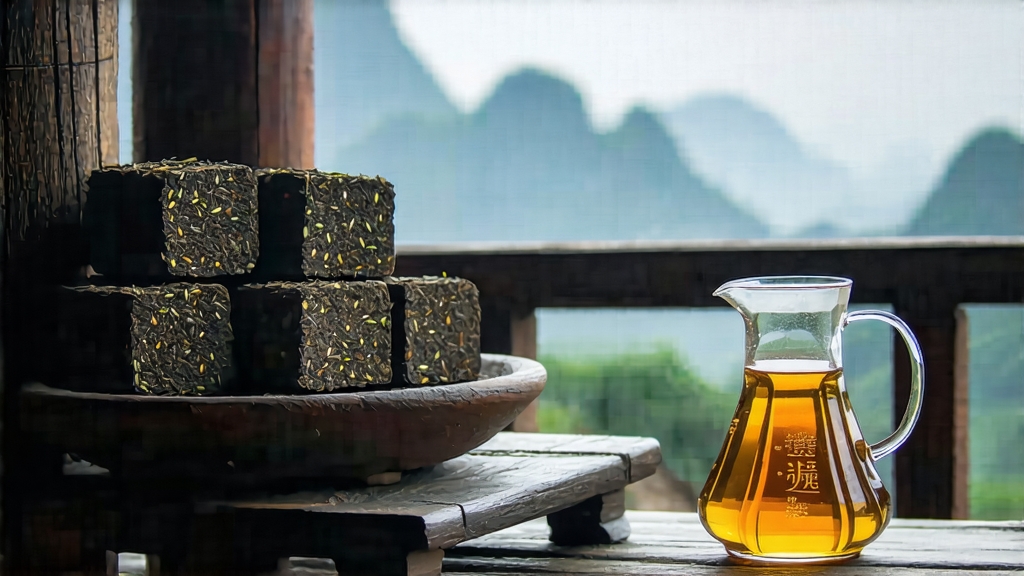
Tucked away in the humid, karst-pocked mountains of southern Guangxi, Liu Bao (literally “Six Forts”) has been quietly perfecting the art of post-fermentation since the Qing dynasty. While Pu-erh grabs the global spotlight, Liu Bao remains the insider’s secret: a tea that travels through time, picking up the scent of camphor forests, river mist and even the betel nut once chewed by dockworkers along the Pearl River. For international drinkers who think they know dark tea, Liu Bao is the plot twist—earthy yet elegant, musty yet mineral-sweet, capable of turning water into something that smells like vintage library and tastes like dark honey on wet stone.
History: From Border Garrison to Global Cargo
The name Liu Bao refers to six ancient fortresses built during the Ming to defend against local uprisings. By the late 1600s the forts had become trading posts where Yao and Han merchants compressed rough tea into bamboo baskets, lashed them to rafts and floated them down the Liu River to Guangzhou. There the tea was trans-shipped to Hong Kong, Macau and eventually Southeast Asia where tin-mine coolies swore it cured damp-heat and malaria. In 1804 the Qing court listed Liu Bao as one of the “Imperial Tribute Teas,” and by 1886 more than 1,500 tons a year left Wuzhou port. The opening of the Suez Canal shortened the voyage to Europe; dock ledgers in London record “Lew Pao” arriving alongside opium and spices. World War II disrupted the trade, and Liu Bao slipped into obscurity until the 1990s when Malaysian collectors—who had been cellaring baskets in 90 % humidity—rediscovered thirty-year-old lots that had developed a dazzling crimson liquor and camphor-cool finish. Today connoisseurs in Kuala Lumpur trade 1970s “Song Ping” baskets for sums higher than first-growth Bordeaux.
Micro-terroir: Why Guangxi Tastes Different
Liu Bao is made only from the large-leaf Da Ye cultivar that grows between 200–600 m on red lateritic soil laced with iron oxide. The region’s annual rainfall exceeds 1,800 mm, but the karst hills drain quickly, forcing roots to dive deep for water and minerals. Morning river fog filters UV light, encouraging the leaves to synthesize more amino acids and theanine. The result is a leaf that is already sweet and low in bitterness before human hands even touch it. Local sayings claim “one mountain, one smell”; teas from the Gupi ridge carry pine resin notes, while those near the turtle-shaped Shi Bao peak lean toward orchid and dried longan.
Craft: The Invisible Eight Steps
- Plucking: only the 3rd to 5th leaf—mature, leathery, already burgundy-edged—picked after 10 a.m. when overnight dew has evaporated.
- Solar withering: leaves are spread on bamboo screens angled toward the west so the afternoon sun softens cellulose without bruising.
- Indoor piling: a 30 cm heap is covered with wet hemp cloth; oxidation starts within two hours, turning the leaf edges chocolate-brown.
- Kill-green: flash-fried at 280 °C for 42 seconds in a cast-iron wok, hot enough to halt enzymatic activity but low enough to keep inner moisture at 55 %.
- Rolling: a peculiar “foot-rolling” survives in three family workshops: barefoot artisans rotate on a 1.2 m bamboo tray, their body weight bruising veins while preserving the waxy cuticle that will later nurture microbes.
- Wet piling (wo dui): the semi-dried leaves are piled 70 cm high, misted with Liu River water, and covered with rice-straw mats. Internal temperature climbs to 62 °C over eight days; thermophilic Aspergillus niger and Bacillus subtilis bloom, breaking down cellulose into soluble sugars and releasing the signature “betel-nut” aroma.
- Basket compression: the tea is steamed for 90 seconds, then rammed into 40 kg bamboo baskets lined with wild banana leaves. The banana leaf contributes vanillin and methyl salicylate, accounting for the wintergreen hint found in aged examples.
- Storage aging: baskets are stacked in humid sub-tropical warehouses where relative humidity